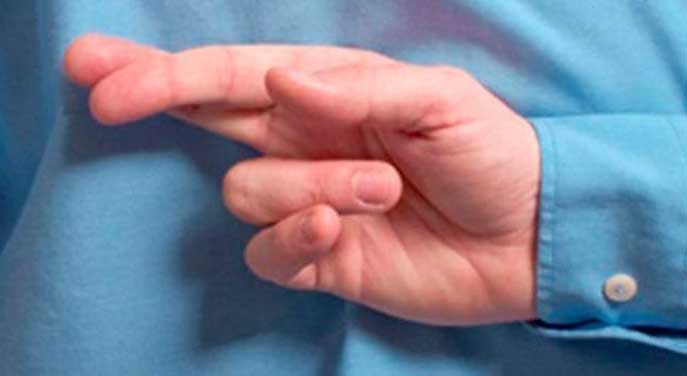 “You’re next in line for a promotion.”
“You’re next in line for a promotion.”
“Let’s have lunch sometime.”
“I’d love to read your report.”
“No, those pants don’t make you look fat.”
We get lied to all the time. People are dishonest out of politeness, to avoid punishment, to protect others, or to deliberately mislead for personal gain.
Some years back, Tim Roth played a character who was a human lie detector on a Fox TV drama called Lie to Me: he could recognize various body language cues that indicate deception. The show’s science is based on solid research in emotions and nonverbal communication. But is it really that easy to spot a liar?
Well, yes … and no.
Yes, liars can “leak” nonverbal information in telltale “micro-expressions” (those genuine emotions that flash across someone’s face in less than one-fifth of a second) and “suppressed expressions,” which slip out before realized and are then replaced with more acceptable reactions. One illustrative thing that Lie to Me did was incorporate photos of real people (Bill Clinton, Saddam Hussein, Kato Kaelin. Simon Cowell). When the actors are caught making a particular facial expression, the show cuts to a photo of a famous person with that same expression, all designed to make the point that there are telltale signs – if you know where to look.
Yes, some behaviours suggest deception. Some examples are:
- Incongruence between what’s being said and the speaker’s body language (like saying “no” while nodding “yes”).
- An increased blink rate – especially over 50 blinks per minute – or eyelid flutter.
- Gazing downward after asserting innocence.
- Shorter, less descriptive statements.
- Incomplete gestures, like a shrug that uses only one shoulder.
- A decrease in hand gestures, especially those used to illustrate speech – like drawing pictures in the air to help explain what is meant.
- Fidgeting feet that shuffle, wind around each other, stretch and curl or kick out.
- Dilated pupils.
- Face touching – especially around the mouth and nose.
- Discrepancies in timing: When the lie is well rehearsed, deceivers start their answers more quickly than truth-tellers. If taken by surprise, however, the liar takes longer to respond.
 |
| Related Stories |
| Do you look like a liar when you’re telling the truth?
|
| Seven steps to spotting liars in action
|
| Lying can be good for our careers |
It’s also true you are already subconsciously picking up on signals of deception; your ability to do that is one of your basic survival instincts. In early human history, rapidly deciding if someone was dangerous or duplicitous was often a matter of life or death. And consistent among the research is that as the importance of having the lie go undetected increases, the more difficult for the liar to conceal the falsehood.
But, as innate as this ability may be and as compelling as the scientific research is, it’s not all that easy to catch a liar. Here’s why …
- There is no absolute signal for deception. Most cues, including blink rates, vocal tone, pupil dilation, etc., are signs of heightened anxiety and stress. But there is no way of telling if the observed stress is caused by lying or something else. Likewise, incongruence, where gestures contradict words, may be a sign of deceit or simply an indication of some inner conflict between what the person is thinking and saying.
- Although done with ease on television shows, micro-expressions occur infrequently and are difficult for most of us to spot without video footage to review. (Suppressed expressions are somewhat easier to see because they appear more often and last longer.)
- Signs of deceit may differ from individual to individual. Take eye contact, for example: some liars shift their gaze and won’t meet your eyes, while others give too much eye contact. One person may raise her vocal pitch when she lies, while another speaks in a flat, unemotional tone.
- Nonverbal cues need to be evaluated in what is called a “gesture cluster” – movements, postures and actions that (taken together) reinforce a common point. A single gesture can have several meanings or mean nothing at all. So when you are trying to catch a liar, you can never do it from a single deceit behaviour.
- It’s tough to spot deception unless you know a person’s baseline behaviour under relaxed or generally stress-free conditions. The more you understand which gestures or postures are part of someone’s unique repertoire, the more you can spot significant deviations from these patterns. That is why police interrogators begin with a series of broad, non-threatening questions to help establish that baseline.
- All nonverbal communication is influenced by cultural heritage; the higher the stress level, the more likely it is that culture-specific gestures will appear. It is extremely difficult to judge nonverbal deception cues in people from another culture.
- No one, not even with the aid of functional MRIs to track brain activity, can identify liars who believe the lies they are telling.
In my speeches to business organizations, I often start with an exercise in which the audience guesses which of four volunteers is lying. And audience members are pretty good at picking out the liar – they just don’t know how they did it. So, if you can find Lie to Me, watch the show. You may come away being a little more discerning about the things people tell you.
Carol Kinsey Goman, PhD, is an executive coach, consultant, and international keynote speaker at corporate, government, and association events. She is also the author of The Silent Language of Leaders: How Body Language Can Help – or Hurt – How You Lead.
For interview requests, click here.
The opinions expressed by our columnists and contributors are theirs alone and do not inherently or expressly reflect the views of our publication.
© Troy Media
Troy Media is an editorial content provider to media outlets and its own hosted community news outlets across Canada.
